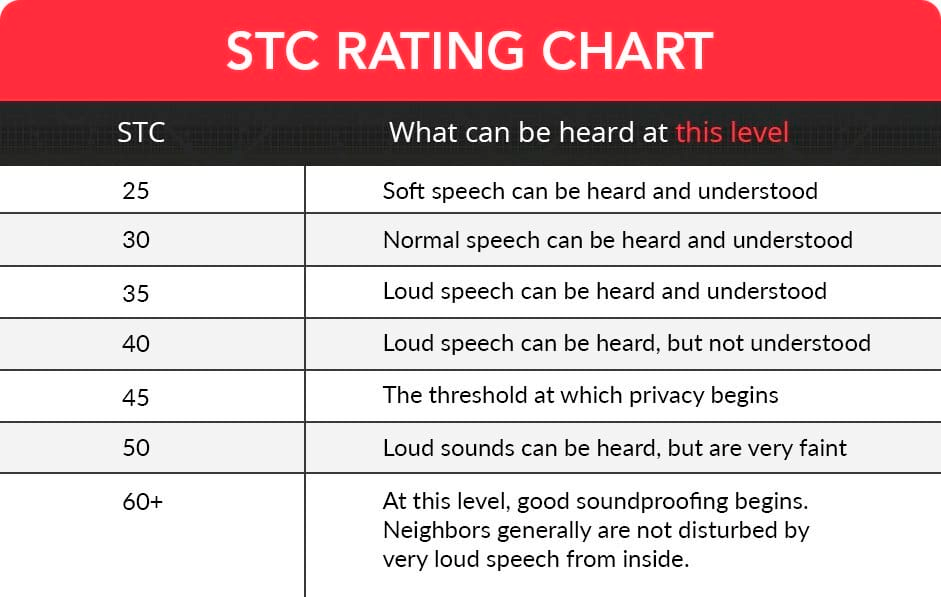
Understanding Sound Transmission Class (STC) Rating
2025-10-03 23:26
Understanding Sound Transmission Class (STC) Rating
If you’re researching STC ratings, chances are you’re working on a serious construction or renovation project — not just a backyard shed. STC, short for Sound Transmission Class, is a critical measurement in environments where controlling noise is important, such as recording studios, road-facing exterior walls, or bedrooms positioned above noisy garages.
Builders and designers rely on STC ratings when selecting materials to reduce sound transfer. Knowing a product’s rating tells you how much sound will be blocked. This measurement is especially important in commercial construction and multi-unit housing.
Introduced in 1961, STC has become the standard single-number rating to describe a material’s ability to block airborne sound. People sometimes mention NRC and STC together — but while STC measures how much sound is blocked, NRC focuses on how much sound is absorbed. The distinction matters: STC is key for reducing noise from entering or leaving a space, while NRC improves acoustic quality inside the room.
How to Measure STC Rating?
Measuring an STC rating might sound technical, but the process is straightforward thanks to ASTM E90 standards. The test involves placing a sample wall, ceiling, or window between two rooms — the ‘source’ and the ‘receiving’ rooms — and then measuring the sound pressure levels at various one-third-octave bands from 125 Hz to 4000 Hz.
The transmission loss across all frequencies is plotted and compared against standardized STC contour curves. The closest matching curve determines the final STC rating for that material.
For example, if your measured curve matches that of an STC 50 reference, the product’s rating is 50.
What is a Good STC Rating?
A “good” STC rating depends on the noise you want to control and your desired level of privacy. For casual speech between two apartment rooms, an STC rating in the low 40s may suffice. However, this will not contain loud basement band practice or heavy mechanical noise. Ratings below STC 40 often lead to complaints about “paper-thin walls.”
Is a Higher or Lower STC Rating Better?
In short: higher is better. A low STC means sound easily passes through, allowing voices and music to be clearly heard on the other side. A high STC enables louder activity without disturbing adjacent spaces.
STC Rating Chart
| STC | What can be heard |
|---|---|
| 25 | Soft speech heard and understood |
| 30 | Normal speech heard and understood |
| 35 | Loud speech heard and understood |
| 40 | Loud speech heard but not understood |
| 45 | Privacy begins — speech not understood |
| 50 | Loud sounds faintly heard |
| 60+ | Excellent soundproofing — loud speech barely audible |
What Does an STC Rating of 45 Mean?
STC 45 marks the threshold where real privacy begins. Conversations in adjacent rooms are inaudible, although faint noise may be detected. While STC 45 works for basic speech privacy, it’s often insufficient for townhouses or condos where structural sound transfer can be significant.
What Does an STC Rating of 50 Mean?
An STC of 50 meets International Building Code requirements for multi-family buildings. At this level, speech is not heard through walls, and loud sounds are reduced to faint traces. Surveys show noise complaints drop sharply once construction meets this benchmark.
Recommended STC Ratings
The National Research Council of Canada recommends STC 55 for most living spaces, with 60+ ideal for areas exposed to loud music or machinery. For simple conversational privacy, STC 45 may be adequate.
What is the STC Rating of Drywall?
Drywall’s STC depends heavily on construction. A standard internal wall — two sheets of ½-inch drywall over bare wood studs — has an STC around 33. Adding fiberglass insulation raises it to roughly 39. For professional-grade improvement, consider acoustic insulation or backing from an acoustic panel manufacturer to significantly boost performance.
What Else Should I Know About STC Ratings?
STC gives a general idea of sound reduction in decibels for midrange frequencies like human speech. It’s less accurate for low-frequency sounds such as bass music or industrial machinery. Also, remember that any soundproofing structure is only as strong as its weakest point — a hollow-core door or single-pane window can undo the benefits of a high-STC wall.
What is a Good STC Rating for Windows?
Single-pane windows typically measure 26–28 STC. Dual-pane designs perform slightly better, but to significantly reduce outdoor noise, consider adding acoustical window inserts. These fit over existing windows and can dramatically improve your home’s rating.
How Can I Improve My STC Rating?
The quickest upgrades involve adding mass to walls or creating air gaps. Filling those gaps with STC-rated insulation like CFAB Cellulose Panels further increases performance. You can also add decorative but functional acoustic treatments — learn how do sound panels work to understand their role in reducing noise levels in a space.
Using What You’ve Learned
STC ratings can dramatically enhance comfort and privacy. By understanding your current conditions and noise sources, you can target cost-effective improvements — from adding insulation to installing new windows or acoustic panels. With the right solutions, that persistent noise can become a thing of the past.







![How Do Acoustic Panels Really Work? [2025]](https://img.waimaoniu.net/4420/4420-202509060002181638.webp?x-oss-process=image/resize,m_lfit,w_400)

